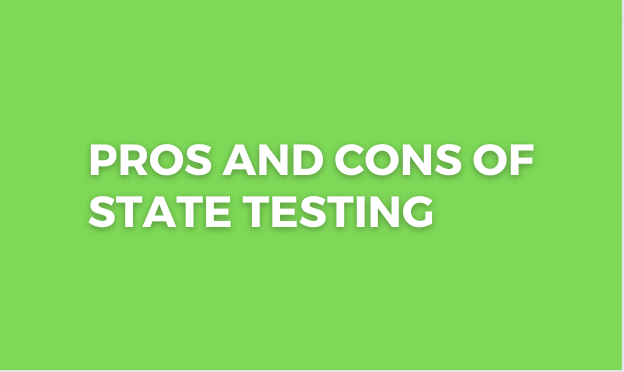State testing is a standardized assessment administered by government education agencies to measure student achievement and evaluate school performance. In the following list, we will explore pros and cons of state testing, covering its potential benefits in assessing student learning, identifying educational gaps, and holding schools accountable, as well as the criticisms and challenges associated with the use of standardized testing.
Pros:
- Assessment of Student Learning: State testing provides a measure of student performance and helps assess their knowledge and skills.
- Identification of Educational Gaps: Test results can highlight areas where students may be struggling, allowing educators to address and target specific learning needs.
- Accountability Measures: State testing holds schools accountable for student achievement, promoting transparency and fostering improvement.
- Evaluation of School Performance: Test results provide data that can be used to evaluate the effectiveness of educational programs and identify areas for improvement.
- Standardized Comparison: State testing allows for standardized comparison of student performance across schools, districts, and states.
- Equity and Fairness: Standardized testing aims to provide equal opportunities for all students, ensuring fairness in the assessment process.
- Data-Driven Decision Making: Test results can inform educational policies, resource allocation, and instructional strategies based on data analysis.
- Alignment with Curriculum Standards: State testing aligns with curriculum standards, ensuring that students are learning the required content.
- Feedback for Teachers: Test results can provide valuable feedback to teachers, helping them identify strengths and weaknesses in their instruction.
- College and Career Readiness: State testing can serve as an indicator of students’ readiness for college and future careers.
- Parental Awareness: Test results provide parents with insight into their child’s academic progress and areas that may need additional support.
- Monitoring Student Growth: Yearly state testing allows for monitoring and tracking student growth over time.
- Recognition of High-Performing Schools: State testing can identify schools that consistently achieve high levels of student performance.
- Identifying Educational Inequalities: Test results can reveal disparities in educational outcomes among different student groups, helping address inequities.
- Quality Assurance: State testing helps ensure a minimum standard of education quality across schools and districts.
- Preparation for Standardized Exams: State testing can familiarize students with the format and expectations of standardized exams they may encounter in the future.
- Transparency and Public Reporting: Test results are often publicly reported, providing transparency and accountability to the public.
- Support for Special Education: State testing can provide valuable data on the educational progress of students with disabilities, guiding support and intervention strategies.
- Identifying Successful Teaching Methods: Test results can highlight effective teaching methods and strategies that lead to positive student outcomes.
- Identification of Gifted Students: State testing can help identify academically gifted students who may benefit from advanced educational opportunities.
Cons:
- Narrow Focus on Testing: Emphasis on state testing may lead to a narrow curriculum, focusing primarily on test preparation rather than holistic learning.
- High-Stakes Nature: The high-stakes nature of state testing can create stress and pressure for students, teachers, and schools.
- Limited Assessment Scope: Standardized tests may not capture the full range of students’ knowledge, skills, and abilities.
- Inherent Bias and Inequality: Standardized tests may have cultural or socioeconomic biases that disadvantage certain student populations.
- Teaching to the Test: State testing may encourage teaching strategies that prioritize test-specific content and neglect broader learning objectives.
- Limited Individualized Assessment: Standardized tests may not accommodate individual learning styles or diverse student needs.
- Time and Resource Intensive: State testing requires significant time and resources, including test administration, preparation, and scoring.
- Pressure on Teachers: The pressure to improve test scores may lead to teaching practices that prioritize test performance over student growth and development.
- Narrow Definition of Success: State testing often measures success solely based on academic performance, overlooking other important aspects of education.
- Stress and Anxiety: State testing can cause stress and anxiety for students, which may negatively impact their performance.
- Labeling and Stigmatization: Test results can label students, teachers, and schools, potentially leading to stigmatization or unfair judgment.
- Unintended Consequences: State testing can lead to unintended consequences, such as teaching to the test, narrowing curriculum, or incentivizing cheating.
- Misalignment with Local Needs: State testing may not align with the specific needs and priorities of individual schools or districts.
- Time Constraints: Limited testing time may not allow students to demonstrate their full knowledge and abilities.
- Pressure on Low-Performing Schools: High-stakes testing may place excessive pressure on struggling schools, potentially exacerbating inequality.
- Reduced Instructional Autonomy: Emphasis on state testing can limit teachers’ autonomy and flexibility in tailoring instruction to their students’ needs.
- Lack of Creativity and Critical Thinking: Standardized tests may not effectively assess higher-order thinking skills, creativity, or problem-solving abilities.
- Test Anxiety and Bias: Test anxiety and cultural bias in testing can disproportionately affect certain student populations, leading to inequitable outcomes.
- Negative Impact on Student Motivation: The focus on testing may negatively impact students’ intrinsic motivation and love for learning.
- Limited Usefulness of Results: Critics argue that state testing results may not provide meaningful or actionable information for improving education.
Pros
- Assessment of Student Learning
- Identification of Educational Gaps
- Accountability Measures
- Evaluation of School Performance
- Standardized Comparison
- Equity and Fairness
- Data-Driven Decision Making
- Alignment with Curriculum Standards
- Feedback for Teachers
- College and Career Readiness
- Parental Awareness
- Monitoring Student Growth
- Recognition of High-Performing Schools
- Identifying Educational Inequalities
- Quality Assurance
- Preparation for Standardized Exams
- Transparency and Public Reporting
- Support for Special Education
- Identifying Successful Teaching Methods
- Identification of Gifted Students
Cons
- Narrow Focus on Testing
- High-Stakes Nature
- Limited Assessment Scope
- Inherent Bias and Inequality
- Teaching to the Test
- Limited Individualized Assessment
- Time and Resource Intensive
- Pressure on Teachers
- Narrow Definition of Success
- Stress and Anxiety
- Labeling and Stigmatization
- Unintended Consequences
- Misalignment with Local Needs
- Time Constraints
- Pressure on Low-Performing Schools
- Reduced Instructional Autonomy
- Lack of Creativity and Critical Thinking
- Test Anxiety and Bias
- Negative Impact on Student Motivation
- Limited Usefulness of Results



